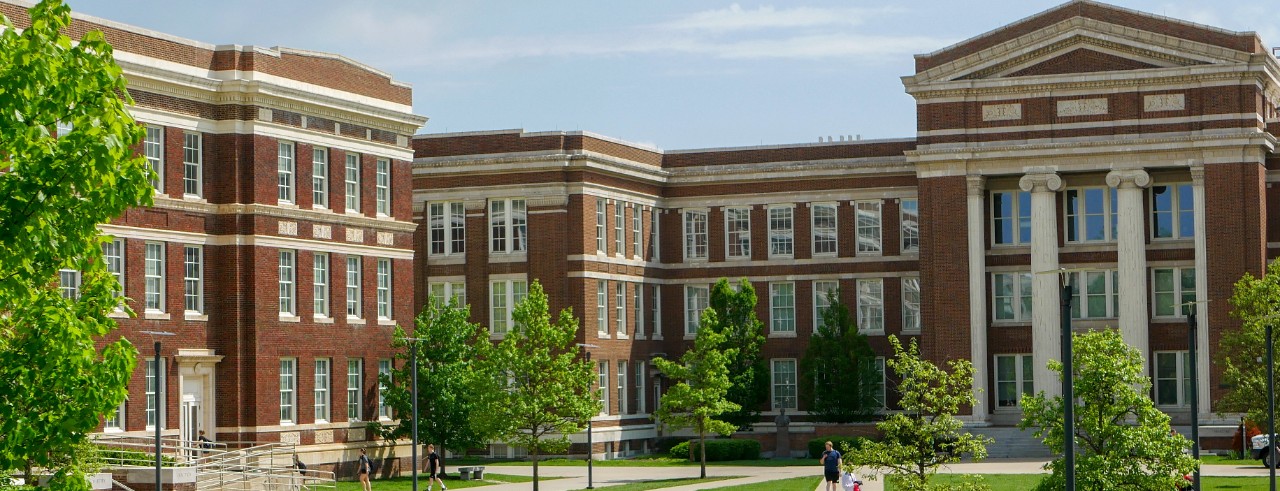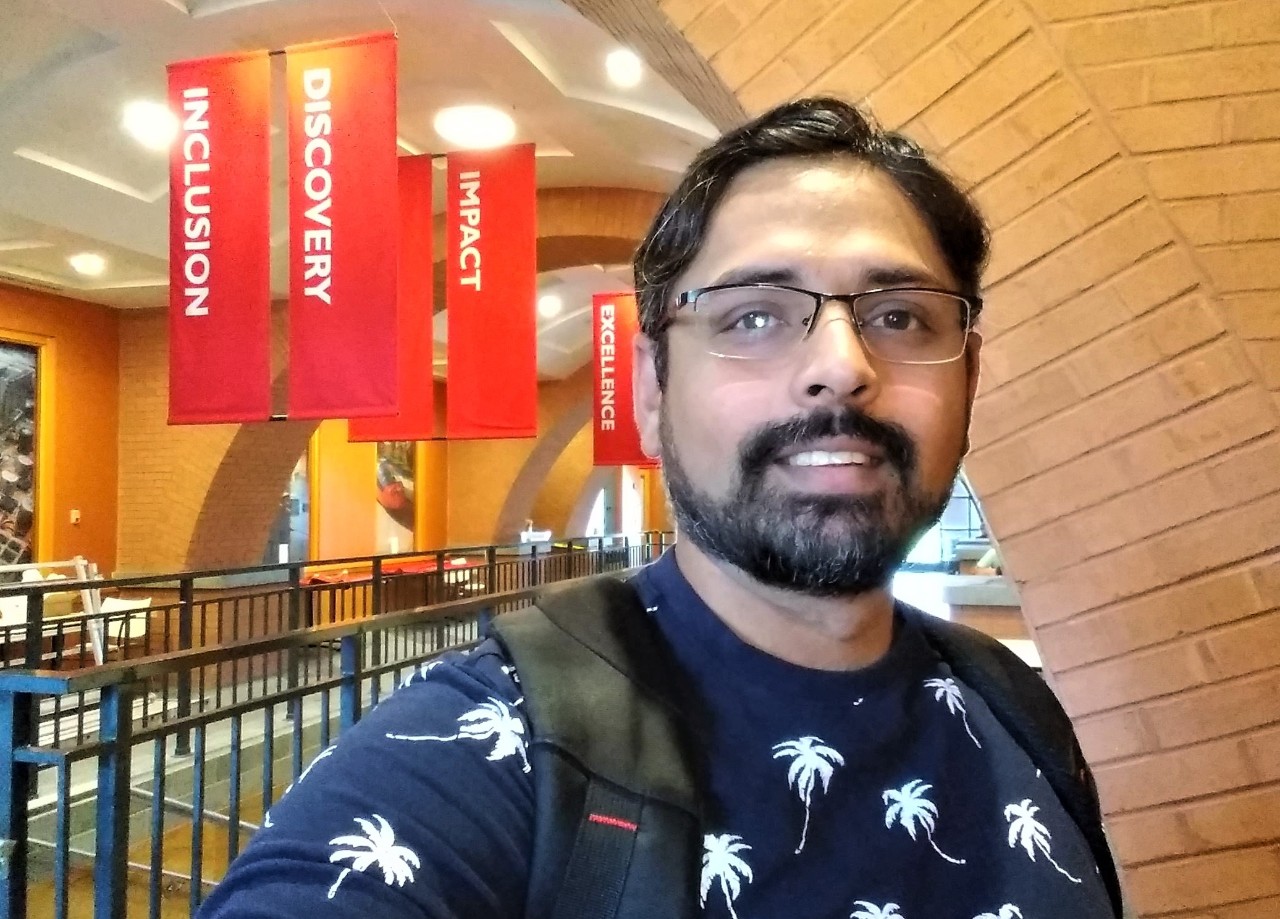
Aerospace engineer works to improve helicopter turbulence at sea
Doctoral candidate Syed Qasim Zaheer named Engineer of the Month
Syed Qasim Zaheer is a doctoral candidate at the University of Cincinnati studying aerospace engineering, with a specialized interest in fluid dynamics and flow turbulence. His doctoral work primarily focuses on the analysis of air wakes from large ships during sea-based operations and how to work towards preventing air wakes from causing turbulence to helicopters that land and take off from the ships.
Zaheer is a recipient of the Professor R.T. Davis Memorial Scholarship and was named Graduate Student Engineer of the Month by UC’s College of Engineering and Applied Science.
What brought you to UC?

Syed Qasim Zaheer in UC's Mantei Center. Photo/provided.
I was inspired to pursue aerospace engineering because of my interest in aviation and the state-of-the-art technologies in the aerospace field.
After completing my master’s in fluid dynamics in 2016, I was selected as a lecturer at the same institution from where I obtained my bachelor’s degree. It was a proud and fascinating journey for me to teach aerospace engineering undergraduate students at one of the most prestigious academic institutions in my country. The teaching experience undoubtedly provided me with an excellent opportunity for continued learning.
After two years working in academia, the urge to enhance and broaden my knowledge base in the field of fluid dynamics increased by multitudes. I wanted to pursue a doctoral program to achieve excellence and proficiency in the subject. The University of Cincinnati’s world-renowned research program has led me to see beyond the horizon. The research interests of the faculty in the Department of Aerospace Engineering and Engineering Mechanics at UC perfectly aligned with my intended research domain. The urban setting of the campus and the lively neighborhood also influenced my decision.
Why did you choose your field of study?
I was mainly introduced to the field of fluid dynamics (especially flow turbulence) during my master’s course and thesis work. The intricacies involved in turbulence flows and the transitions from smooth and relatively simple laminar flow fascinated me.
After completing my degree, my inquisitiveness and desire to understand and explore the mysteries of fluid dynamics (especially related to flow turbulence) intensified, which led me to pursue my doctoral studies in the field of fluid dynamics here at UC.
I was fortunate enough to secure admission in the Ph.D program for aerospace engineering, where I learned from the advisership of Dr. Peter J. Disimile, who possesses vast experience and knowledge of flow turbulence.
Briefly describe your research work.
We’ve all had the experience of driving within the air wake of trailer trucks on highways, when the side forces whiplash on cars and makes it difficult to keep the steering. Luckily, we drive on roads where the friction and traction provide us with the necessary counter resistive forces.
Think of a situation when an object is suspended within air wake flow conditions. Helicopters are a great example of this, with the harsh environment that they encounter while performing sea-based operations. They execute landing, takeoff and hovering maneuvers on flight decks of large marine vehicles like frigates/destroyers.
The flow turbulence in the wake of the ship’s superstructure highly deteriorates the handling qualities of helicopters, which increases the workload of pilots. Therefore, it’s imperative to characterize the turbulence on the flight deck of large naval ships. This is the scope of my doctoral research, with my primary focus on analyzing the peculiar characteristics of ship air wakes.
With a better understanding of those air wakes, we can find ways to reduce the turbulence experienced by hovering helicopters.
What are some of the most impactful experiences you've had during your time at UC?
The close relationship between the industry and academia here at CEAS, along with the research in both applied and theoretical domains, have influenced me a lot.
Additionally, I was lucky to meet Eugene L. Fleeman during an aerospace engineering graduate seminar at CEAS in the fall of 2019, where he presented his vast experience and research in the field of missile design. I followed his book, "Tactical Missile Design,” during my final year project for undergrad in which I performed the preliminary design and trajectory optimization of a supersonic air-to-air missile, so this was a memorable moment for me. I was impressed by his work for its conciseness, and how it was simultaneously simple and thorough.
Of what accomplishments are you most proud?
I’m proud of the concrete and novel analysis I performed on fluid dynamics problems encountered throughout my research work, being carried out as an RA, course projects, and my thesis dissertation. This enabled me to publish the quality results of my research in in two conference papers and five peer-reviewed, high-impact factor journals.
It was also a big honor for me to receive the 2022 Professor R.T. Davis Memorial Scholarship and the UC CEAS Graduate Student Engineer of the Month award for my academic excellence and leadership qualities.
Most recently, I was awarded the highly prestigious and competitive URC Graduate Student Stipend and Research Cost Program for Faculty-Student Collaboration award to perform summer fellowship on novel research.
What are your plans after earning your degree?
I hope to defend my Ph.D. dissertation in the spring of 2024. My long-term career goal is to hold a tenured position at a university, or an R&D unit of a prestigious industrial organization. In either position, I would have the opportunity to apply my academic exposure and focused research, not only in improving designs; but to make the world a safer place by contributing my knowledge towards the field of fluid dynamics.
Learn more about UC engineering graduate programs
Discover the advantages of a graduate degree from the UC College of Engineering and Applied Science.
Related Stories
UC student aims to better interpret artificial intelligence
May 24, 2021
Javier Viaña Pérez started his studies in mechanical engineering earning two degrees in his native Spain and then came to the University of Cincinnati for his master’s and Ph.D. in aerospace engineering. He has racked up a long list of accomplishments, including creating a high-resolution camera for microsatellites that is currently in use on the International Space Station. His doctoral research in artificial intelligence is dedicated to making a radical shift in how we think about AI. He was named UC College of Engineering and Applied Science Graduate Student Engineer of the Month.
Engineering student makes sense of waves
July 9, 2021
When Parikshit Boregowda, mechanical engineering doctoral student at the University of Cincinnati, is staring at ocean waves crashing into the shore, he’s thinking about the problems he can solve through better modelling methods to study the motion of fluid.
WCPO: UC's 3D printers help young engineers change the world
January 14, 2021
WCPO talks to UC College of Engineering and Applied Science professor Sam Antoline and UC student Arshad Mohammed about the growing use of 3D printing for research and manufacturing.
